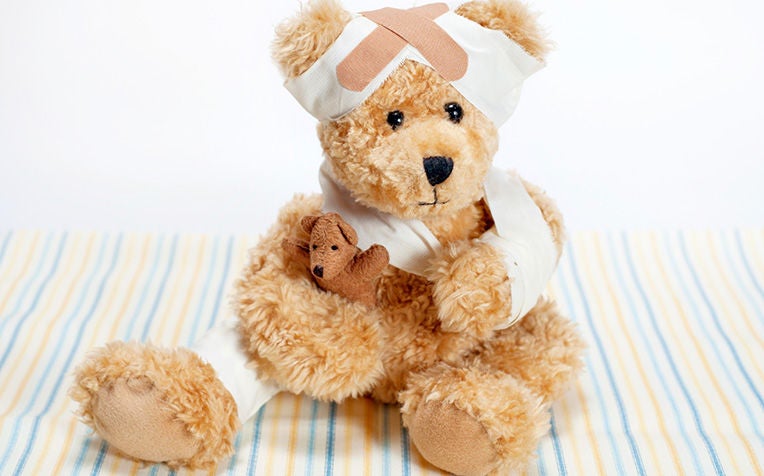
Children's emergency Parents should be prepared to handle emergencies like burns, choking, and so on.
Being prepared to handle acute emergencies at home is an important skill for parents with infants and young children. Many accidents can be prevented if you have some knowledge about infant emergency care.
“Infants are curious by nature. While crawling around and grasping objects, they may pick up small objects like buttons and coins, put them in their mouths and choke on them,” says Clinical Associate Professor Yeo Cheo Lian, Head & Senior Consultant, Department of Neonatal and Developmental Medicine, Singapore General Hospital (SGH), a member of the SingHealth group.
Infant choking is one of the four most common infant acute emergencies, besides burns, accidental drowning and swallowing of poisonous liquids.
Look out for three vital signs in a children's emergency
The infant’s appearance, skin colour and breathing effort are indicators of the severity of the condition.
Get emergency help if you notice:
- White, pale or mottled skin
- Vacant, glassy-eyed stare
- Listlessness and no response to stimuli such as the mother’s voice
- Laborious breathing noises (e.g., grunting, wheezing or high-pitched whistling sounds)
- Flared nostrils (shows that infant is trying very hard to breathe)
Tips on infant emergency care
Be on the alert for these acute emergencies:
1. Choking
Choking can cause infant death if the trachea or windpipe is completely blocked.
What to do:
- If the infant is able to breathe and is coughing, let him cough the object out.
- If the object is visible, remove it by scooping it out using a single finger. Do not attempt to remove it if you can’t visualise it. Blind sweep may cause object to lodge further inwards.
- If the infant is unable to talk or breathe normally, try dislodging the object from the trachea by doing the Heimlich manoeuvre – slapping five times between the infant’s shoulders (making sure the infant is facing downwards).
- If the infant shows no response, perform Cardiopulmonary Resuscitation (CPR) and call 995 for an ambulance.
2. Accidental poison swallowing
The infant may accidentally swallow liquids such as liquid detergent, essential oils or mouth rinse. Once these chemicals get into the bloodstream, they may damage the internal organs.
Signs of poisoning: Vomiting, tremors, sweating, abdominal pain, burns around the lips and mouth, loss of consciousness.
What to do:
- Seek emergency care. Tell the doctor your infant’s age, weight, condition, what he or she may have ingested and time of suspected poisoning. Follow the treatment instructions.
- If your infant is unconscious, call 995 for an ambulance. Give the above information.
- Do not give the infant milk or induce vomiting unless advised by the doctor.
- If the infant has stopped breathing, perform CPR as an emergency care procedure.
3. Accidental drowning
Accidental infant drowning can happen anywhere in the house – toilets, buckets or baby bathtubs.
What to do:
- Check the three vital signs (infant’s appearance, skin colour and breathing condition).
- Perform CPR if the infant shows no pulse or is not breathing.
- Call 995 for an ambulance.
4. Accidental burns
Scalding from hot water and hot liquids such as soups and cooking oil is a common cause of accidental burns in infants. Other causes include chemical burns caused by contact with pesticides or detergents and electrical burns from biting electrical cords or touching electrical sockets.
Signs of a burn: Pain and redness (first-degree burn), blisters and severe pain (second-degree burn), dry and white or charred black skin, and little or no pain (third-degree burn).
What to do:
- For minor burns, cool the burnt skin under cold, running water or immerse in cold water. Do not put ice on the burn. Do not break any blisters. Apply a moisturiser on the burn and protect it with gauze.
- For chemical burns, flush the area with running water.
- For electrical burns, first switch off the source of electricity (with a non-metallic object such as a wooden stick), then move the infant away from the electrical source with a non-metallic object (not your bare hands).
- Perform CPR. Call 995 immediately.
5. Serious allergic reactions
Anaphylaxis is a serious allergic reaction to particular foods, medications, or insect bites.
Signs of a serious allergic reaction: Widespread hives, swelling of the eyes, mouth and/ or tongue, wheezing, breathlessness, fainting.
What to do:
- Call 995 for ambulance
- If your child is known to have severe allergic reactions, immediately give an Epipen injection to the outer thigh
6. Childhood seizures
Simple fever-related seizures (fits) are common in children between the ages of 6 months to 6 years old. Although they may look frightening, these fits are generally harmless to children.
What to do:
- Lay the child on the side (recovery position)
- Remove any objects near the child that may injure him / her while he/ she is fitting
- Do not insert any objects into the child’s mouth
- Insert rectal diazepam (if available)
- If the seizure lasts > 5 minutes, call 955 for ambulance
- If the seizure lasts < 5 minutes, you should still bring your child to a doctor for further evaluation
Parents can learn more about infant emergency care by attending a Basic Resuscitation Course organised by the Department of Neonatal and Developmental Medicine at Singapore General Hospital.
Ref: P16

















 Get it on Google Play
Get it on Google Play